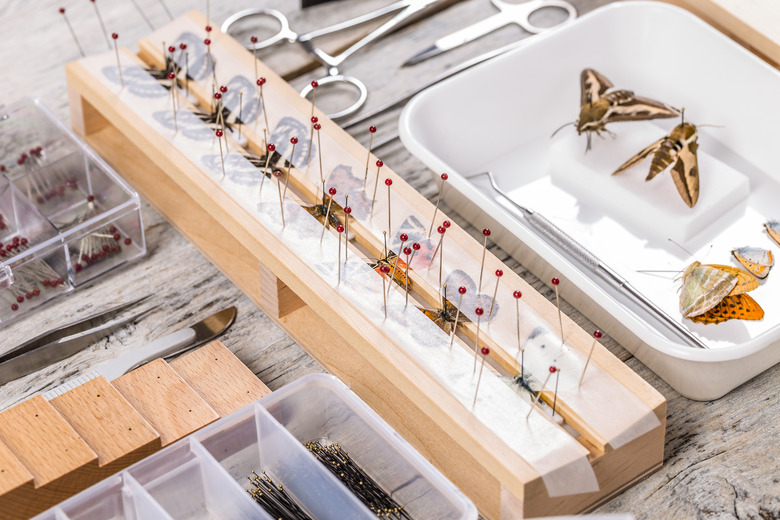How To Preserve A Dead Butterfly
When it comes to insects, the butterfly is definitely in a league of its own. Most people see ants, flies and wasps as pests but are intrigued by a butterfly's grace and beautifully colored, intricately patterned wings. The process of preserving bugs is called entomology. Preserve a dead butterfly to keep it bright and beautiful forever.
Things Needed
- Jar or plastic box
- Paper towel
- Water
- Antiseptic
- Insect pins
- Smooth, spade-tip forceps
- Foam mounting board
- Paper
- Tightly closed box
- Mothballs or paradichlorobenzene crystals (optional)
1. Relax the Specimen
When bugs die, they quickly become brittle. Create a relaxing chamber from a jar or plastic box with a folded paper towel that is moistened with water at the bottom of the container. Add an antiseptic to prevent mold growth. Place the butterfly on the paper towel base and keep the container closed for two to seven days, depending on its size (larger butterflies need longer to relax).
2. Pin the Specimen
Remove the relaxed butterfly from the chamber. Hold it carefully by the thorax (the center body part) and push an insect pin through the middle of the thorax between the wings. If necessary, push the wings backward to push the pin far enough through the body. Force the wings down with smooth, spade-tip forceps after pinning. Pin the butterfly onto a foam mounting board, keeping the section where the wings attached to the body just above the surface of the board.
3. Mount the Wings, Body and Antennae
Fold the wings underneath small strips of paper and pins. Don't touch the wing surfaces with your fingers as this can remove their scales. Pull the front wings forward, one at a time, with insect pins. Only insert pins into the wings immediately behind the larger wing veins to avoid ripping. Move the front wings forward enough to create a nearly straight line with their hind margins. Move the hind wings forward underneath the front wings to match their color patterns. Pin the antennae and abdomen in the correct positions. When you're satisfied with the position of the wings, body and antennae, remove the pins from the paper strips to just outside the wing margins, tightening the strips as you go. Place larger pieces of paper on the rest of the exposed wing surface to stop curling. It takes up to a week to dry your specimen, depending on size, temperature and humidity. Remove the pins and get rid of the paper strips when the specimen is dry.
4. Store the Specimen
Keep the mounted butterfly in a tightly closed box away from direct sunlight to prevent fading and in low-moisture conditions to prevent mold growth. Add mothballs or paradichlorobenzene crystals if the butterfly is stored for long periods in dark conditions to prevent carpet beetles and book lice from feeding on the body parts.
TL;DR (Too Long; Didn't Read)
If the butterfly is still alive, the best way to kill it is to pinch its thorax between your thumb and forefinger. Fold its wings over its back and slip it into an envelope.
Use size 000 to 00 insect pins for the smallest butterflies, size 0 to 1 insect pins for most butterflies, and size 2 to 3 insect pins for large butterflies.
If a wing breaks off, pin it next to the specimen, position the other wings, and glue the wing back in place with repair adhesive when the specimen is dry.
Cite This Article
MLA
Gillespie, Claire. "How To Preserve A Dead Butterfly" sciencing.com, https://www.sciencing.com/preserve-dead-butterfly-6024693/. 5 April 2018.
APA
Gillespie, Claire. (2018, April 5). How To Preserve A Dead Butterfly. sciencing.com. Retrieved from https://www.sciencing.com/preserve-dead-butterfly-6024693/
Chicago
Gillespie, Claire. How To Preserve A Dead Butterfly last modified March 24, 2022. https://www.sciencing.com/preserve-dead-butterfly-6024693/
